Despite being introduced in the 1970s and 1980s, CT and MRI continue to be the primary imaging modalities for the temporal bone and skull base. Although the general concepts and physics remain the same, the images obtained currently are far superior. Augmenting these traditional modalities are nuclear medicine imaging techniques, functional imaging, and the fusion of different techniques. Advances in these areas are expanding our options and illuminating pathology in unique ways. As basic physiologic processes are better understood, new opportunities for novel imaging techniques should arise.
Despite being introduced in the 1970s and 1980s, CT and MRI continue to be the primary imaging modalities for the temporal bone and skull base. Although the general concepts and physics remain the same, the images obtained currently are far superior. Augmenting these traditional modalities are nuclear medicine imaging techniques, functional imaging, and the fusion of different techniques . Advances in these areas are expanding our options and illuminating pathology in unique ways. As basic physiologic processes are better understood, new opportunities for novel imaging techniques should arise.
This article focuses on the advantages of the latest MRI, CT, and nuclear medicine technology and the impact it has on clinical practice and research. Not only is the image acquisition technology changing but also our methods for viewing the images are evolving. It is becoming increasingly uncommon to have actual printed films, and images are routinely viewed in an electronic format. Although this transition to electronic viewing can be uncomfortable because it is a change, there are some distinct advantages.
To a large degree, the success of the transition to an electronic system depends on the specific image viewing software and hardware. An intuitive, easy-to-use program and computer monitors of sufficient size and quality ease the transition. Tools that allow the clinician to quickly identify image series of interest (eg, axial postcontrast), rapidly scroll through images, make measurements, and compare scans from different times are all critical for a successful experience. The ability to scroll up and down through a series of images makes it easier to visualize the three-dimensional image of the pathology in comparison to looking at traditional films. This ability is particularly important because of the large number of images obtained for most examinations. It is not uncommon to have 400 to 1000 images for a single CT scan. Reviewing a stack of printed MRI or CT scans requires identifying the different series and much organizing, which in the electronic environment is unnecessary. The clinician can simply choose the series of interest (eg, T1 postcontrast) for review. Improved labeling by radiologists and user-friendly software are making review an efficient task.
CT
CT scanning became widely used in the 1970s. Because of the exquisite bony detail it can provide, it is beneficial for assessing temporal bone and skull base lesions. Although the fundamental technology has remained the same, every facet of the process has been improved. Higher quality images are obtained in less time with less radiation exposure.
The most recent technologic advance is the advent of multidetector (multislice) scanners . The current generation of 64-slice scanners ( Fig. 1 ) allows for rapid volumetric image acquisition with resolution in the range of 0.3 to 0.6 mm. Because the data are acquired for an entire volume in a single pass, there is no need for performing scans in multiple planes (axial, direct coronal, and sagittal). The volumetric data can be reformatted rapidly in any desired plane and without loss of resolution, which is a tremendous improvement that allows visualization of the anatomy in novel ways . Another advantage is that current scanning protocols require approximately 5 to 10 seconds for image acquisition. The incredibly rapid acquisition time greatly reduces motion artifact and often the need for sedation in infants or young children, which reduces not only the risk of the procedure but also the cost to the health care system.
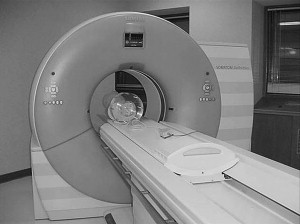
Enhanced resolution has improved diagnostic accuracy. Superior semicircular canal dehiscence syndrome ( Figs. 2 and 3 ), otosclerosis ( Fig. 4 ), ossicular chain abnormalities ( Fig. 5 ), labyrinthine ossification, cochlear implant location, and inner ear malformations ( Fig. 6 ) are just a few areas that have benefited from improved resolution .
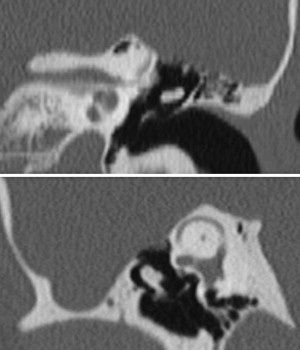
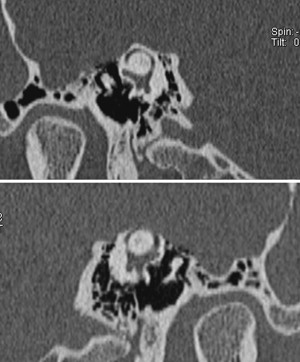
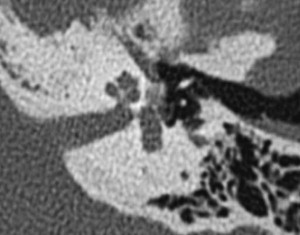
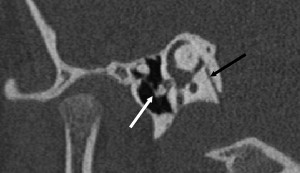
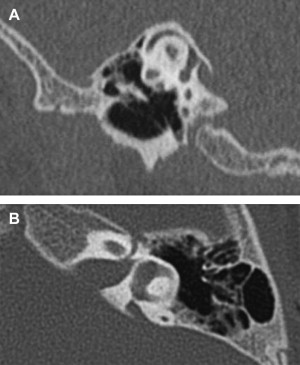
CT angiography
CT angiography can be performed on multidetector CT scanners as a noninvasive means to obtain information concerning the skull base arterial anatomy . The technique can be useful for identifying an aberrant carotid artery or assessing vascular malformations or the interface between tumors and arterial vasculature. Contrast is given during image acquisition and the image viewing software is used to subtract out bone and other structures to allow isolated views of the arteries. The high quality of these images often obviates the need for a formal angiogram.
Office-based CT scanners are becoming increasingly popular and offer the advantage of convenience for the patient, perhaps obviating the need for a return visit. Image quality is not as good as the latest generation standard scanners but is certainly adequate for some clinical situations.
CT angiography
CT angiography can be performed on multidetector CT scanners as a noninvasive means to obtain information concerning the skull base arterial anatomy . The technique can be useful for identifying an aberrant carotid artery or assessing vascular malformations or the interface between tumors and arterial vasculature. Contrast is given during image acquisition and the image viewing software is used to subtract out bone and other structures to allow isolated views of the arteries. The high quality of these images often obviates the need for a formal angiogram.
Office-based CT scanners are becoming increasingly popular and offer the advantage of convenience for the patient, perhaps obviating the need for a return visit. Image quality is not as good as the latest generation standard scanners but is certainly adequate for some clinical situations.
Rotational tomography
One limitation of conventional CT is the artifact caused by metallic implants, such as a cochlear implant, stapes prosthesis, or other ossicular prosthesis. Rotational tomography is a technique that reduces the metallic artifact and allows for more precise identification of prosthesis location . It uses equipment typically used for angiography and is widely available.
The DynaCT capable angiography unit has a rotating C-arm that acquires images ( Fig. 7 ). Slice thickness and voxel size are 0.4 mm, and images are acquired in approximately 5 to 20 seconds, depending on the number of projections. Because data are volumetric, they can be reformatted and processed in the same manner as data acquired with a multislice CT scanner. Another potential advantage of this technique is a reduced radiation exposure—10 to 15 mGy compared with 20 to 60 mGy for conventional CT . Although the latest CT technology demonstrates less metallic artifact, rotational tomography may result in more sharply defined prosthesis location. This clinical technique is being used in some centers after cochlear implantation, but more experience is needed to define its role compared with conventional CT. Both technologies are moving closer together and are not dissimilar beyond the physical structure of the device. Cadaver and temporal bone studies suggest that it may be useful in the evaluation of ossicular prosthesis, but more clinical experience is needed.




